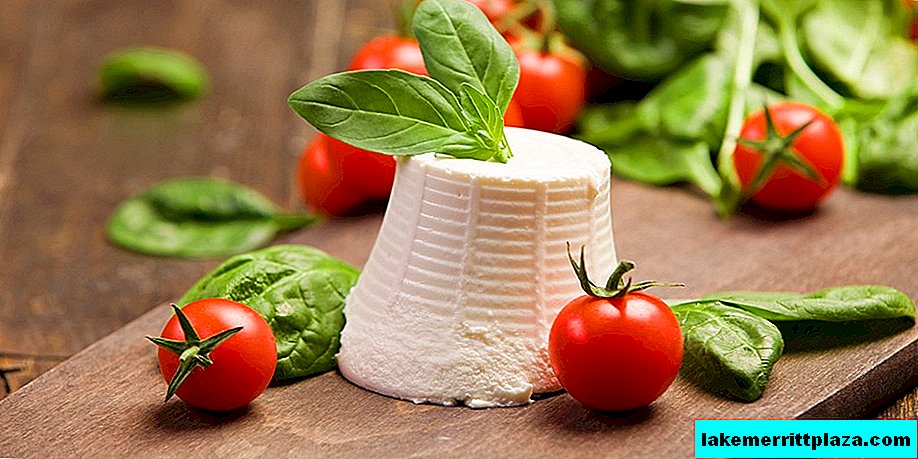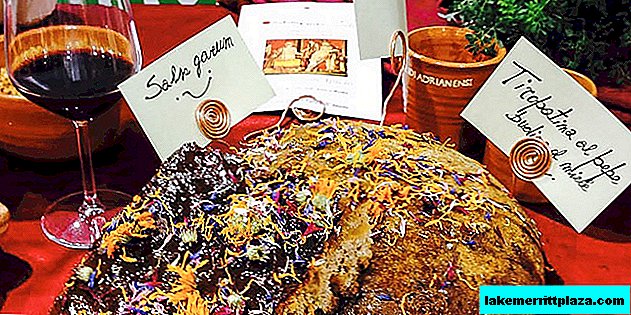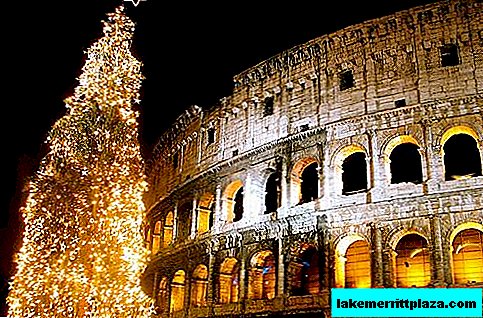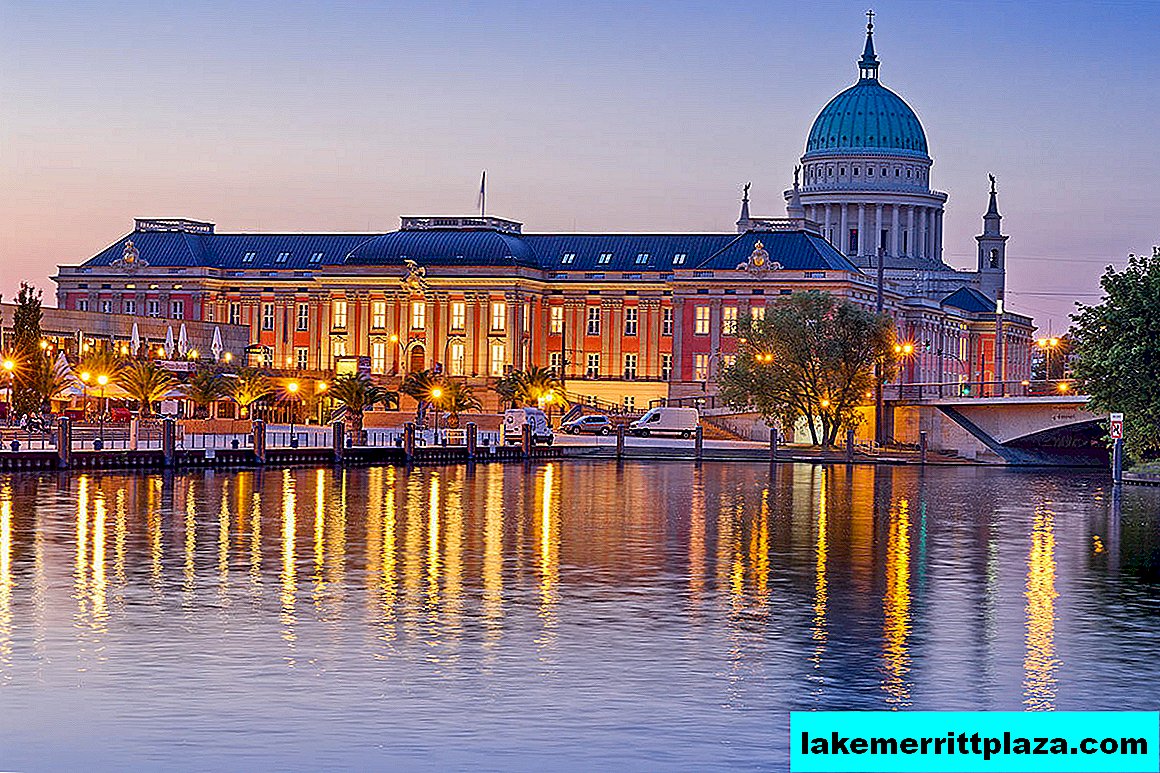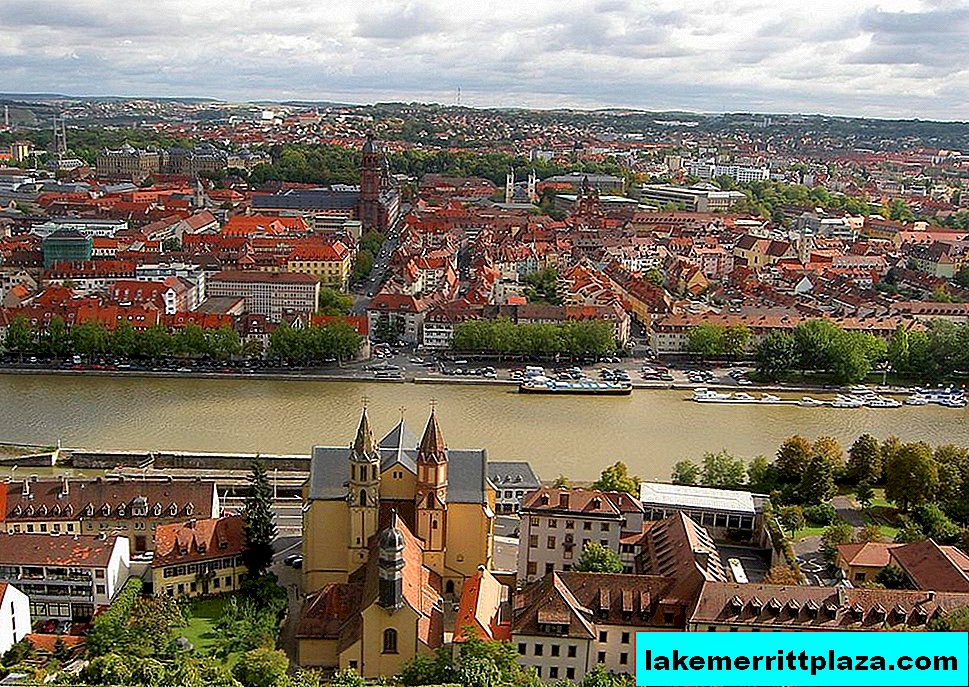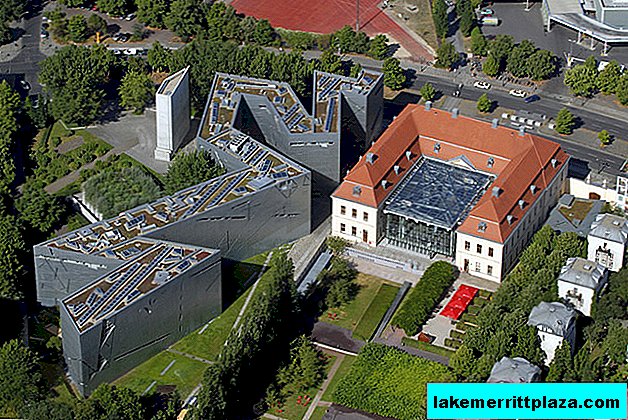The sights of Siena are interesting because many houses, palaces and temples have been preserved in their original form. Many of them were even pardoned by the bombing of World War II, which destroyed many architectural masterpieces. That is why there is no doubt that every stone in the historical part of the city, every house and temple is not the skillful work of restorers, but a real medieval rarity that has come down to us through the centuries.
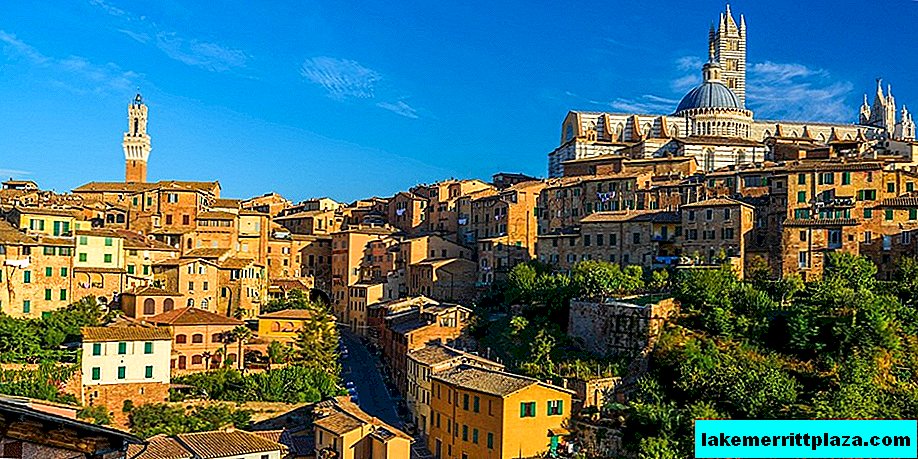
Where is
Siena is the administrative center of the province of Tuscany (Toscana). Located in the northwest of Rome (Roma), the capital of Italy, 184 km in a straight line. On the geographical map it can be found at the following coordinates: 43 ° 19'07 "north latitude, 11 ° 19'54" east longitude.
The area of Siena is 118 km2, and consists of seventeen counteras (districts), each of which bears the name of an animal, has its own emblem and legend. The historical center is located on 6 km2. Since the Middle Ages, the city has maintained its appearance of inaccessibility thanks to the surrounding walls and hills. The narrow streets of Siena are almost devoid of vegetation, but they breathe easily due to the fact that the center is closed for cars.
- See instructions: how to get to siena
Central square
The main square of Siena is Piazza del Campo, arranged in a place where the three hills meet, on which Siena is located. It differs from other areas in a unique shape: during the arrangement of the Piazza del Campo, it was given the shape of a shell, the circumference of which is 333 m.
Such the original solution, the area owes a lot of rain streams, which, descending from the hills, formed a peculiar relief. Also, during the arrangement of the square, the authorities made sure that the buildings did not violate its plan. So, the basilica of Peter and Paul (chiesa dei Santi Pietro e Paolo) was demolished only because it stood a little ahead in comparison with the houses of the local aristocracy.

The first documentary information about Piazza del Campo appeared in 1169, when it became necessary to put in order the area where the square is now located. At first it was a single whole with the neighboring Piazza del Mercato. But after a while, a wall was erected between them to restrain the convergence of rain streams.
Until the end of the XIII century. there was a bazaar on the square, fairs were held. In 1287, when the era of "Tyranny of Nine" came (nine people ruled the city, representatives of trade corporations), a need arose for a new city hall.
The construction of the Palace of the Commune (Palazzo Pubblico) on the square was the beginning of the appearance of other institutions important for the city. The most famous buildings here are the Tower of Glutton (Torre del Mangia), the chapel di Piazza (Cappella di Piazza), the fountain of Joy (Fonte Gaia), the palace of Sancedoni (Palazzo Sansedoni), the chapel (Cappella di Piazza).
Palace of the Commune

The Palace of the Commune (Palazzo Pubblico) is the central building of Campo Square. Previously, it housed the old city building "Bolgano" (palazzo del Bolgano), which it was decided to expand and rebuild. So, if at first the main facade of the house went towards Piazza del Mercat, after reconstruction the front side of the city hall was in the opposite direction.
Although the end of construction dates back to the XIV century., After three hundred years, the Palace of the Commune, it was decided to expand by building the side parts. At the same time, the facade was decorated.
During the construction of the Palazzo Pubblico, the architects repeated the bend of the square. The central part has four floors and one tier above the side wings. In the center of the fourth floor is a white circle on which a monogram of Christ is depicted. The roof of the building is a bit like a fortress: it has rectangular battlements.
The first floor is faced with white stone, the upper floors are bricked. Each window consists of three parts that frame two small columns and three lancet arches. Above each of them is a vaulted arch, decorated with the coat of arms of Siena. To the numerous holes that are visible on all the walls of the town hall, scaffolding was once attached.
Palazzo Pubblico has long served as the city administration, which occupied all the rooms of the palace. Now the city hall is located only on the second tier. Below is the City Museum (Il Museo civico), which houses frescoes and other creations of local artists. In the near future it is planned to equip the museum on the third tier. In addition to the museum, the Rinnovati Theater (Teatro dei Rinnovati) is located at the bottom of the Town Hall.
Glutton Tower

The Glutton Tower (Torre del Mangia) is adjacent to the Commune Palace and is located on its left side. So strange people called the building in honor of the first guard attractions, Giovanni di Balduccio (Giovanni di Balduccio). He was known for his indefatigable appetite, and therefore spent all his money on various delicacies.
Torre del Mangia is one of the highest towers of the Middle Ages: if you take into account lightning rods, its height is 102 m. You can climb to the observation platform, which is located at an altitude of 88 m, after breaking four hundred steps. It offers a magnificent view of the surroundings.
The construction dates back to the first half of the XIV century: the tower began to be erected in 1338, completed ten years later. To protect the attraction from thunder, hurricane and other misfortunes, happy moments and stones with protective inscriptions written in Latin and Hebrew were laid in the foundation of the building. In addition, the building during construction was positioned so that its sides were clearly oriented to the west, south, north or east.
The bell appeared in the belfry in 1349. But its sound quality was not the best, so in 1634 it was replaced. But the new alarm bell left much to be desired, due to which thirty years later it was replaced by a bell, which is located on the bell tower today. Due to the large size (and it weighs a little more than 6.5 tons), the townspeople installed it above the belfry. True, its sound is uneven, and depends on where the bell language hits.
For several decades, the watchman beat the bell. Then, first, a wooden one appeared on the bell tower, then an automatic mechanism that announces the time so far. The bell itself sounds only on special holidays.
In 1360, a clock appeared on the tower. The dial was depicted on the tower half a century later, and at the end of the XVIII century. it was carved from stone and decorated with a fresco with a canopy (they were lost in the XX century after restoration).
Chapel di Piazza
The chapel di Piazza (cappella di Piazza) is located on the first floor of the tower of the Glutton. It is lined with white marble, effectively standing out against the background of a terracotta tower. Made in the Gothic style.
They began to build the chapel in 1352, dedicating the Virgine, thanks to which the bubonic plague left Siena, which claimed the lives of many citizens (this happened in 1348).
The construction lasted for two decades, and was completed in 1376. After some time, the facade was decorated with sculptures, a canopy in the Renaissance style. In the XVI century. a fresco by Giovanni Antonio Bazzi (Giovanni Antonio Bazzi) appeared in the chapel, depicting the baby Jesus, Our Lady and God the Father. Now the fresco is stored in the museum of the town hall.
Sancedoni Palace

The most notable private building on the square is the Palazzo Sansedoni Palace. There is a house opposite the city hall to the right of the fountain of Joy.
The building of terracotta color, built in the Gothic style, appeared here at the end of the XIII century. by order of Goro Sansedoni. For this purpose, five aristocratic houses located here were combined. In the center of the composition is a high tower, which in the XVIII century. after the earthquake was greatly shortened due to fear that it might collapse.
Between the 17th and 18th centuries the house was restored, expanded, but the facade retained its features: its arcuate curve follows the shape of the Piazza del Campo. The interiors were redeveloped, decorated with statues, frescoes. A chapel dedicated to Ambrogio Sansedoni, a monk who lived in the 12th century, was preserved.
Now it houses the offices of Fondazione Banca Monte dei Paschi.
Fountain of Joy
Fountain of Joy (Fonte Gaia) is located opposite the city hall. He does not immediately strike the eye, and more like a white marble pool, which can be well seen only from one side of the square. The fact is that the fountain is fenced on three sides by marble walls. Decorate their bas-reliefs depicting biblical subjects, as well as the Virgin and Child Jesus. On the front pilasters you can see two women. One of them gave birth to Romulus and Remus (Romulus and Remus), the founders of Rome, the other - raised (according to legend, the son of Remus, Senius founded Siena).
Fonte Gaia appeared at the beginning of the XV century. and was originally intended as a pool for collecting water, which was supplied here from underground canals.

Water fills it, which flows from tubes clamped in the mouths of she-wolves (they are located on the sides of the bowl). Particular attention of tourists is attracted by the clear bluish water splashing in the pool. The fountain owes its name to the joy that engulfed the townspeople when they saw here the water breaking from the ground.
In the XIX century statues and panels were replaced with copies, and the pool itself was surrounded by a fence. Now the original elements of the fountain are stored in the Museum of the Hospital Santa Maria della Scala (Complesso museale di Santa Maria della Scala).
Churches
The main and most magnificent temple of Siena is the Cathedral (Duomo di Siena), which is located on Cathedral Square (Piazza del Duomo). The rest of the temples look more ascetic, but also interesting, since the most famous artists, architects, sculptors of Italy worked on them.
Cathedral

The Cathedral (Cattedrale di Santa Maria Assunta or Duomo di Siena) is the main church of the city, built on Cathedral Square. In ancient times, there was a temple. The Romans demolished it and erected a fortress, on the sides of which four towers were arranged. During the construction of Duomo di Siena, one of them was converted into a belfry. Before the beginning of X century here was the residence of the bishop.
The construction of the landmark began in 1220, and lasted a half century. The plan of the temple is a Latin cross. The front facade is faced with white marble, decorated with sculptural compositions. It is a successful combination of different styles of Gothic. The lower part of the temple is Roman, the upper is late, the portals are French. Mosaics at the top of the church appeared in the XIX century. Above the central portal there is a huge round rose window, on the edges of which there are sculptures of prophets and apostles. On the sides of the window, on the right and left sides of the building, are beautifully decorated galleries.
The rear facade and side walls are faced with white marble slabs with horizontal inserts of dark green marble. The twelve-sided dome rises above the middle cross, which is decorated with images of saints inside.
It is impossible to take your eyes off the painting of the walls of the temple. The altar of the temple consists of three niches: at the bottom are sculptures of the apostles by Michelangelo (Michelangelo), on the top - sculpture of Jacopo della Quercia (Jacopo della Quercia) "Madonna and Child". The left nave houses the Piccolomini library (Biblioteca Piccolomini).
The tower of the old fortress was converted into a belfry in 1333. Its height was 77 m. Like the external walls of the temple, the bell tower is lined with white-green lines. The belfry has six rows of windows, the size of which increases with each next tier (the narrowest one at the bottom). Crowns the bell tower spire.
Crypt

The crypt of the Cathedral (Cripta del Duomo di Siena) is located on its territory. Despite the name, the relics are not stored here, although it is believed that in the temple there really is still an undetected crypt.
Presumably, crypt appeared at the end of the XIII century. and was walled up during the expansion of the temple. That is why her presence remained secret until 1999, when the crypt was discovered during restoration work. Here you can see the whole cycle of frescos of the XIII century, which adorned the templethat was here before the construction of the cathedral. They are distinguished by their bright colors and well-preserved images of saints.
Baptistery of St. John the Baptist

The Baptistery of St. John the Baptist (Battistero di San Giovanni) stands near the Cathedral. In order not to grease the impression of the baptistery, it is better to visit it before a visit to Duomo di Siena. Located attraction on the Piazza San Giovanni.
They built a baptistery in 1325, and starting this year all the townspeople, both aristocrats and commoners, were baptized here. Although the top floor has not yet been completed, the facade is a gothic masterpiece. Like the Cathedral, it is lined with white marble with dark green stakes, decorated with floral and geometric elements. Three portals lead into the building.
The hexagonal font was created in 1430 from marble and bronze. Its panels are decorated with bas-reliefs and sculptures by Donatello (Donatello), Lorenzo Ghiberti (Lorenzo Ghiberti), Giovanni di Turino (Giovanni di Turino), Jacopo della Quercia (Jacopo della Quercia).
Frescoes decorated the building in the middle of the XV century. They were worked on by Vecchietta (Il Vecchietta), Michele di Matteo Lambertini (Michele di Matteo Lambertini), Benvenuto di Giovanni (Benvenuto di Giovanni), Piero Orioli (Pietro degli Orioli).
Now the attraction is part of the museum Museo dell'Opera Metropolitana. Paid entrance.
Basilica of St. Dominic

The Basilica of St. Dominic (Basilica di San Domenico) is located on Piazza San Domenico, 300 meters from Piazza del Campo. The attraction is located on a hill, and is clearly visible from many points of the city. And from the observation deck overlooks the city center, including the Cathedral.
The Dominicans founded the church in 1226, and it took two hundred years to build it. The building is completely made of red brick. From the outside it looks very ascetic, representing an example of strictly Gothic architecture, which was typical for the structures of mendicant orders. The bell tower appeared in the XIV century, but two centuries later it was damaged during the earthquake, after which it became lower.
You can get into the church only from the side, since the main facade is missing. Inside the temple is a richly decorated chapel. Here, behind the lattice glass, is kept the head and finger of St. Catherine (Caterina Benincasa), who lived at the church for most of her life. Therefore, the church has many pilgrims, and on its walls you can see paintings that depict episodes from the life of Caterina Benincasa.
Basilica of St. Francis
The Basilica of St. Francis (Basilica di San Francesco) is located on Piazza San Francesco, half a kilometer from Piazza del Campo. It is better to see the temple before visiting the Cathedral, otherwise it will not impress: the Gothic building looks simple and ascetic.

The basilica was built in the middle of the XIII century. outside the city walls. In the city, she was only two hundred years later. The basilica has repeatedly expanded, rebuilt and rebuilt. In the XVIII century. a bell tower appeared near her. The facade in the neo-Gothic style appeared at the end of the XIX century.
In the chapel of the temple store the "Eucharistic miracle of Siena." These are two hundred consecrated prosphores (liturgical liturgical bread) that were stolen in 1730. After some time they were found in the church of Chiesa di Santa Maria di Provenzano and returned to the church of St. Francis. They say that prosphora is still fresh.
Osservanza Basilica
The Basilica of Osservanza (Basilica dell'Osservanza) is built on top of the hill Colle della Capriola. It is on the outskirts of Siena, in the northeast of the city. The church is one of the most important churches of the city that are located outside the city walls.

The temple was built in 1490 on the site of the old monastery of the XII century. Dedicated to Saint Bernardino of Siena, who had died half a century earlier and lived on this hill. Five years later, the temple was expanded by order of Pandolfo Petrucci, who decided to make a family crypt here, and at the same time equip the monastery.
During the siege of Siena in 1554, the monastery complex was completely destroyed, but the townspeople quickly restored it. In the twenties of the last century, the attraction underwent reconstruction. At the end of World War II, after the bombing of the temple remained ruins. The complex was restored after ten years according to the drawings provided by the monks. Therefore, the temple has the same appearance as before the war.
Museums
There are a lot of museums in Siena. Many of them are located in the Cathedral Square area, as well as Piazza del Campo. Although the museum map in the city does not work, you can save. The fact is that Combined tickets are popular in Siena, according to which you can visit several exhibitions at once, which in the end will be cheaper.
That is why before buying a ticket to a particular museum, you need to ask at the ticket office about the availability of such an opportunity.For example, a ticket purchased to visit the Museo dell'Opera Metropolitana also allows you to see the Cathedral, the crypt and the baptistery.
When visiting the museum, if you do not want to book a tour, you should ask if there is an audio guide. This will make the visit more interesting.
City Museum

The City Museum (Museo Civico) is located at the bottom of the Palace of the Commune, at Piazza del Campo. He appeared in the thirties of the last century.
Visitors to the museum can see the halls of the old town hall, decorated with famous Sienz. This is the Globe Hall (Sala del Consiglio), where the Council of the Siena Republic once met. The name was given to him by a previously stored rotating disk with a map of the republic depicted on it. The Hall of Nine, where the meetings of this government took place, will also be interesting.
In the museum you can not only trace the history of Siena, but also get acquainted with the creations of famous Siena masters. Simone Martini and Ambrogio Lorenzetti worked on the frescoes that adorn the walls of the town hall. The frescoes are interesting in that most of them depict non-religious themes. Pictures tell about various methods of city management, which can lead to its prosperity or decline.
Museo dell'opera metropolitana

Museo dell'Opera Metropolitana is located at Piazza del Duomo, 8. It is better to visit after visiting the Cathedral, which is located on the same square.
Many original items are stored here, copies of which are exhibited at Duomo di Siena. There are also copies of statues and mosaics that adorn the cathedral. Due to this, they can be clearly seen close up, which is impossible to do in the temple.
In the halls of the museum are stored marble statues of Donatello, Jacopo della Quercia, Francesco di Giorgio Martini. The altarpiece “La Maestà” by Duccio di Buoninsegna stands out especially. The artist took three years to make this masterpiece. At the same time, he concluded a special contract with the city, according to which he was not limited in expenses, but he had to work on La Maestà alone, without an assistant.
In addition to church attributes, objects of art, in the halls of the museum you can see household items of the local aristocracy. Among them are carpets, tapestries, tablecloths, handmade curtains.
From the museum you can climb the unfinished facade of the new Cathedral (the construction, grandiose in scale, was supposed to replace the old temple, but because of the plague and the decline of the city, it was not completed). A magnificent view of the square and the surrounding area opens up from above. This is the advantage of the museum over the cathedral, on the bell tower of which there is no viewing platform. You can leave the museum through a beautifully designed small baroque-style church.
To visit the museum it is better to purchase a combined ticket. It will be cheaper and will also allow you to see the cathedral, baptistery, crypt.
Museum Museum of Santa Maria della Scala

The Museum of the Hospital Santa Maria della Scala (Complesso museale di Santa Maria della Scala) is located on Piazza del Duomo, 2. The exposition is located in the hospital shelter of the ninth century, designed for poor people. It was called Ospedale di Santa Maria della Scala.
The museum on the territory of 13 thousand m2 was opened in 1995. It is very unusual and diverse, each hall is different: there are frescoes, here is a chapel, there are relics of saints. A little further - underground labyrinths, then halls, narrow corridors. The large hall of the former hospital is decorated with frescoes that belong to the XV century, which depicts the daily life of the shelter. The center of the composition is the Church of the Holy Annunciation (Chiesa della Santissima Annunziata), located at the hospital, built in the XIII century.
In addition, the National Archaeological Museum of Siena (Museo Archeologico di Siena) is located on its territory. You can look at modern painting.
To visit the museum is cheaper to take a combined ticket. It will allow you to visit several more attractions.
National Pinacotheca

The National Pinacoteca (Pinacoteca Nazionale) is located on Via San Pietro, 29. The exposition will appeal to people who are fond of medieval religious painting. There are many icons and paintings on a Christian theme, and only on the fourth floor can you see secular paintings.
The exposition is housed in two palaces, the Palazzo Bridzhigi and Buonsignori (palazzi Brigidi e Buonsignori). The appearance of the first refers to the XIV century, the second to the XV century. The Pinakothek was opened here in 1932. The exposition is based on the collection of paintings by Abbot Giuseppe Chuckery (Giuseppe Ciaccheri), who lived at the end of the XVIII century. After that, it was replenished with canvases that were presented to the city by noble citizens. Almost all of the museum’s exhibits are creations of the picturesque school of Siena of the 13th-17th centuries, occasionally you can see the canvas of the 18th century.
On the fourth floor is the Spannocchi collection, which appeared in the museum in 1977. Here are the creations of Flemish, Dutch, German and North Italian painters. In the same year, a sculpture hall of masters of the XIV-XV centuries was opened in the Pinakothek.
Museum of torture
Museum of Torture (Museo della Tortura) - a sight not for the faint of heart. therefore children are not recommended here. It is located a few meters from Piazza del Campo, in the lower part of the square on Chiasso del Bargello, 6.
Here are about two hundred types of torture tools, which are located on two floors. There are few tormented bodies, so it does not make a particularly grave impression. But nevertheless, several fake tortured bodies, human skeletons and skulls are exhibited for clarity. Information on the history of exhibits is presented in Italian and English. You can also book a tour.
Houses
Siena has a lot of interesting palaces and houses. Among them stands out the house where St. Catherine, the patroness of Siena, lived in childhood, the house where the city council gathered before the appearance of the Palazzo Pubblico, as well as a commercial loggia. Despite the fact that it’s unlikely to get inside this attraction, and from the outside it makes a stunning impression. The Medici fortress, which the Florentines built as a symbol of their final conquest of Siena, will also attract attention.
House of St. Catherine

The home of St. Caterina (Santuario cateriniano), the patroness of Siena, can be found on Costa di Sant'Antonio. Now it is a whole complex, which consists of loggias, galleries, arcades, chapels.
She was born in the second half of the XIV century, and lived in this house until tonsure. In 1466, the city bought a house and built a sanctuary here, which provides for several chapels, built on the site of a dye, kitchen and other premises.
A chapel was equipped in the dyeing shop, which was later transformed into the Church of the Crucifixion (La chiesa del Crocifisso). Services are still held here. The walls of the temple are decorated with frescoes depicting paintings from the life of Catherine. Here you can also see a statue of a saint carved from wood.
Near the upper chapel, which used to be the kitchen, and now is the front of the Crucifixion Church, are the Oratorio della Camera. Near them is the saint’s room, where some of her personal belongings are stored. On the floor you can see a stone ledge, which she used as a pillow.
Chigi Saracini Palace

Palazzo Chigi-Saracini can be found on Via di Citta '89. This is the construction of XII, which appeared on the order of the influential family Marescotti (Marescotti). On the left side of the attraction you can see the tower, which in the Middle Ages signaled the financial well-being of the family. In the courtyard of the palace is a well, chapel, portico, decorated with various paintings.
Before the arrival of Palazzo Pubblico, the Council of the Siena Republic met here. In the XVI century. the house was bought by the Piccolomini del Mandolo family. Two hundred years later, he was in the possession of the Saracini clan, after which the building was expanded, and the facade acquired a curved shape that repeated the bending of the street.
At the end of the XIX century. the house was inherited by Fabio Chigi. In 1932, Count Guido Chigi Saracini founded the Accademia Musicale Chigiana, where students from all over the world study, was established inside the building.
Within the walls of the Academy there is a museum where canvases of famous Italian artists and sculptors are stored. Among them you can see the creations of Sandro Botticelli, Sassetta (Il Sassetta), Domenico Beccafumi (Domenico di Giacomo di Pace Beccafumi). Here you can also see jewelry and ceramic products, a collection of musical instruments.
Trading loggia
A commercial loggia (Loggia della Mercanzia) can be found near the Piazza del Campo, at the place where the three streets intersect: Banchi di Sopra, Via di Citta, Banchi di Sotto. There used to be a commercial court. From the 18th century here is the closed club Circolo degli Uniti, so it's hard to get inside.

A loggia appeared at the beginning of the XV century, and therefore combined elements of the Gothic and Renaissance. The house itself is located behind the fence, which is a wide high arches connected by a trellised fence. The pillars between them are decorated with various bas-reliefs, statues of saints, patrons of Siena, as well as Peter and Paul. The arches of the loggia are decorated with stucco and frescoes, the appearance of which dates back to the XVI century. The second floor appeared in the XVIII century. In the courtyard in front of the house are two benches made of marble. One is decorated with reliefs signaling virtues, the other - the famous Romans.
Medici Fortress
The Fortress of Medici (Fortezza Medicea) is known as the Fortress of St. Barbarians (Forte di Santa Barbara). The attraction is located on the Piazza della Libertà, 800 meters from the Piazza del Campo.
The citadel is a symbol of the end of the Siena Republic and the final conquest of the city by the Florentines. The order for its construction was given in 1561 by the ruler of Florence (Firenze) Cosimo Old Medici (Cosimo I de 'Medici). The construction site was not chosen by chance: Previously, there was a Spanish fortress, which the townspeople destroyed a few years before. The construction of the citadel was completed in 1563.

The result was a powerful rectangular brick structure. Its width on the outside was 200 m, length - 270 m. Bastions towered in the corners. On three of them placed the coat of arms of the new owner Siena. There were also equipped platforms for shooting heavy artillery from cover.
At the end of the XVIII century. Fortezza Medicea disarmed. In 1937, a city garden was arranged on the territory of the fort, walking through which you can admire the city and its surroundings.
The citadel itself has become a museum: temporary expositions are often held within its walls, a library and an audio archive are located. Also here is the Siena Jazz Association (associazione Siena Jazz), which constantly holds concerts and lectures for musicians. In the dungeons of the fortress there is a shop where you can taste, and if you wish, buy expensive wines.
Rinnovati Theater
The Rinnovati Theater (Teatro dei Rinnovati) is the largest theater in Siena: it is designed for 549 seats. The Melpomene Temple is located on the first floor of the Palazzo Pubblico, which is on the Piazza del Campo.
The history of Teatro dei Rinnovati began in 1536, when King Charles V (Carlo V) decided to organize a major celebration in the city. There was no theater in Siena then, and so it was decided to equip it in one of the halls of the town hall, setting up a stage and equipping places. A hundred years later, the hall underwent significant reconstruction: 107 lodges were arranged in it.
In 1742 the theater burned down, was restored and opened ten years later. But a year later, the fire again destroyed a significant part of the hall. This time, the work did not last long, and the theater was again opened to the audience in the summer of 1753.
The disasters of the Melpomene temple did not end there: the earthquake of 1798 severely damaged it. This was the reason that the club of aristocrats l'Accademia degli Intronati, to which the theater belonged, sold it to the Rinnovati Academy - and the hall was restored. In the XIX century. the building was reconstructed more than once (the royal box, stage, dressing rooms, decor was updated).
In 1927, the Rinnovati Theater was closed and sold to the city. Ten years later, robots began here to protect the building from fire. During the second world restoration was suspended, resumed after the war.
The opening of the theater in 1950 was timed to coincide with the week of music in Siena. After that, it no longer closed.
City fortifications

The walls of Siena (Mura di Siena) are a defensive circular fortification consisting of walls, towers and bastions that surround the medieval part of Siena. That is why you can get to the historical center through numerous portals.
The citizens built the defensive walls of Siena over several centuries (VIII-XV centuries) in five stages, as the inhabitants increased. Mura di Siena has one feature: usually, as the city grew, new walls were erected around the old ones, taking them into a ring and then dismantling them. Here, additional sections were simply attached to the existing walls, which surrounded the new part of the city without destroying the old line of fortifications. Many walls, as well as the gates leading to Siena, have survived to this day.
Parks
There is very little vegetation in medieval Siena. But near the center you can find several parks where you can relax in nature. This is a botanical garden, All'Orto de 'Pecci, giardini la Liza, giardini Publici.
All'Orto de 'Pecci

Take a break from the hustle and bustle of the city at All'Orto de 'Pecci, whose entrance is located on Via di Porta Giustizia 39, a five-minute walk from Piazza del Campo. This is a small and cozy garden, in which peacocks, donkeys, goats walk in the summer.
You can’t organize a picnic here (this is being watched), but you can visit an inexpensive restaurant. Two pizzas, two beers and a cola will cost 22 euros here. True, in the season it is completely packed and there may not be a free table. The garden offers a beautiful view of the historical center, first of all, the Obzhora tower and the city hall are clearly visible.
Botanical Garden
Entrance to the Botanical Garden of Siena (Orto Botanico dell'Università di Siena) is paid. Therefore, he received a lot of criticism from tourists who paid 5 euros and found him somewhat groomed. Nevertheless, lovers of exotic flora will like it here.
Here you can see insectivorous plants, rare flowers, Rock Garden, fern forest. At the entrance to the park, two pools with aquatic plants are equipped.
The Botanical Garden covers an area of 2.5 hectares. The main entrance is located on Via Pier Andrea Mattioli, 4, half a kilometer from the Cathedral. Open daily.

A botanical garden appeared in Siena in 1588, when, on the initiative of a local university, medicinal plants began to be grown near the hospital of Santa Maria della Scala.
Two centuries later, the territory was not enough for botanists, and it was decided to move the garden to its current place. Already in the first report published on the work of the garden, it was reported that there were nine hundred species of flora from different parts of the world. For plants, the local climate of which was not suitable, special greenhouses were equipped.
What is a Palio

One of the most interesting events that take place in Siena is the Il Palio, in which seventeen contractions of Siena take part. To this end, Piazza del Campo is filled with sand around the perimeter, which is removed at the end of the jump. Before the competition they organize a costume parade.
In Palio, 10 out of 17 concards take part. To determine which of them will participate in the races, before the competition, representatives of the districts draw lots. Interesting that during the races, the main thing is not the riders, but the horses: even if the jockey fell, and the horse continued to run and won, he won. Siena are rare riders: jockeys from other cities are invited to participate in the Palio.
Competitions are held twice a year. For the first time - on July 2 in honor of the Madonna of Provenzano, who saved Siena from the invaders. The second action takes place on August 16, in honor of the Ascension of the Virgin. Sometimes, for some special reason (the transition to the new century, the anniversary of the unification of Italy), additional races are organized.
How to get there
Although Siena is located in the center of Tuscany and there are many attractions, it is located away from the main tourist routes. Therefore, the nearest airports that serve domestic and international lines are located an hour or two from the city. But there is a bus station where international buses arrive, as well as a railway station to which regional trains arrive.
- See instructions: how to get to Siena yourself
Aircraft
Nine kilometers from Siena there is a small airport "Siena Ampugnano", but passenger planes do not fly here: it is mainly used for private and business flights. Therefore, To get to Siena, you need to take a plane ticket that flies to Florence or Pisa (Pisa). You can also go from Rome (Fiumicino Airport), but the road will take two hours: on the highway, the distance between cities is 268 km.

The distance between Florence and Siena is 80 km. This is an hour by car, we recommend renting in advance at auto.italy4.me
From L'Aeroporto di Firenze-Peretola airport you need to get a minibus to the Santa Maria Novella railway station (Stazione di Firenze Santa Maria Novella) and take a train ticket. Better on a straight line, but if it doesn’t work, then you need to change trains at the Empoli station. Near the train station, on via Santa Caterina da Siena, 15, there is a bus station. Here you can take a bus ticket that goes directly to Siena.
The airport in Pisa is named after Galileo Galilei. From here you can leave for Siena by bus directly from the airport. The distance between cities is 160 km. Tiemme and TerraVision IT buses depart from the airport:
- Tiemme buses spend two hours on the road, traveling through Florence. Tickets cost 15 euros, two ways - 28 euros. The schedule can be found here: tiemmespa.it;
- TerraVision IT buses depart from the airport once an hour, travel through Florence and spend three hours en route. Tickets cost 28 euros. Schedule here.
Marozzi VT buses leave from the Park Pietrasantina bus station, located on via Fazio degli Uberti (20 minutes from the airport). Arrive at the Stazione FS station. Check the timetable on the official website of the company www2.marozzivt.it.
Train Station

The train station (La stazione di Siena) is located at piazza Carlo Rosselli, 2.5 km from Piazza del Campo. Trains from different points of Tuscany come here. For example, from Florence you can get here in an hour and a half.
More information on the train schedule can be found here: www.e656.net/orario/stazione/siena. It should be noted that in the upper left corner you need to click on one of the four windows where the time of approximate departure of trains is indicated: 00-06, 06-12, 12-18, 18-24.
There is no direct communication with Rome. That's why you need to go with a change at the Grosseto station or Chiusi-Chianciano Terme station.
Siena Railway Station is two kilometers from the center, so you can walk (the walk takes half an hour). It is also possible to wait for the bus that goes to Piazza Antonio Gramsci or take a taxi (about eight euros).
Bus
The bus station in Siena is located at Piazza Antonio Gramsci. Its rates can be found here: www.tiemmespa.it/index.php/Viaggia-con-noi.

From here, ten minutes walk to the Cathedral. In appearance, the bus station is more like a bus station: there are several aprons, closer to the city center there is a sign. In the middle is an elevator that takes you down to the ticket office. You can also get to them by crossing the road and going down the stairs.
Here you can buy bus tickets to another city, which will need to be stamped at the entrance to the bus. No tickets are sold on the bus itself.
When planning to use the bus when traveling to another city, it should be borne in mind that although officially he arrives faster than the train, if it gets stuck in traffic, arrival can be too late. Therefore, if a business meeting is planned, it is better to give preference to the train.

